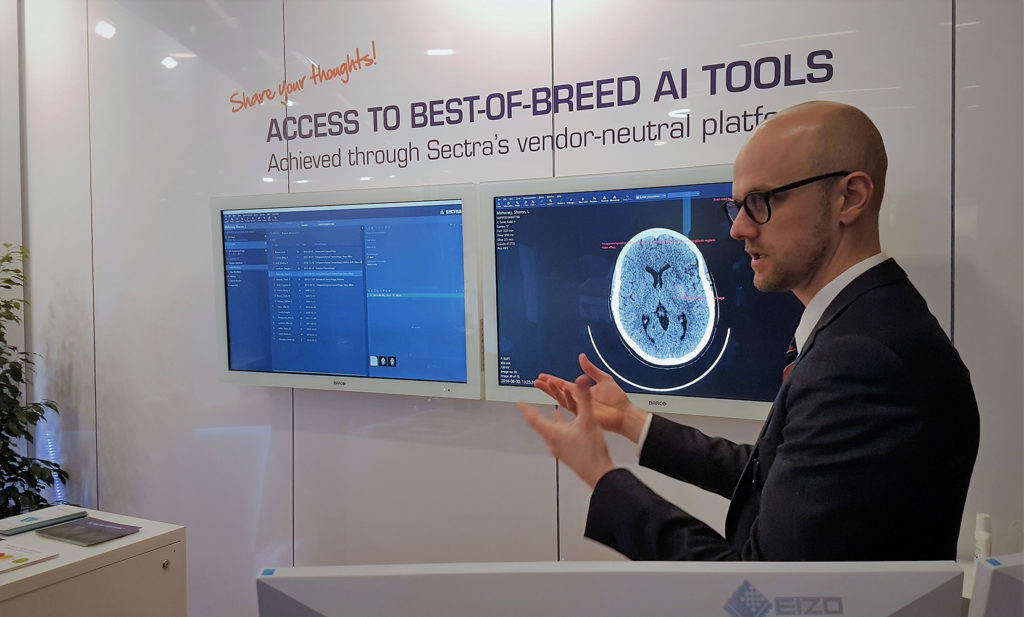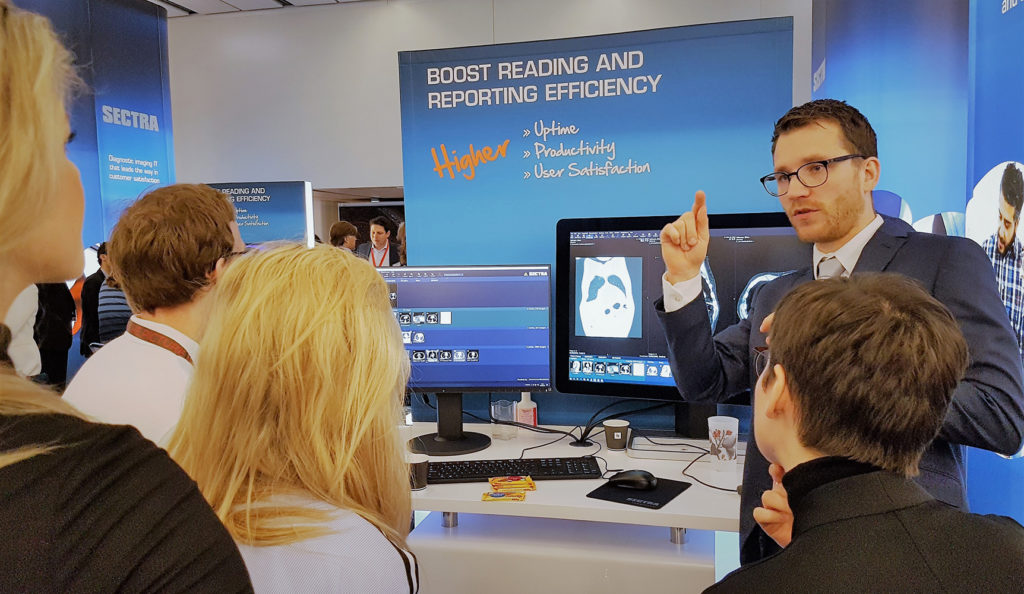ECR has closed its doors for this year. Once again, I am amazed by the enthusiasm among the attendees and vendors when it comes to bringing new innovations to improve healthcare. As many of us have ECR’s big brother congress, RSNA, fresh in our memories, it comes as no surprise that there were no significant market shifts at ECR. Instead, we can conclude that incremental changes are taking place in existing trends. The main trends worth noting from this year’s ECR are listed below.
Artificial intelligence (AI)
The hype has declined a bit, but AI still dominated the congress floor. AI is here to stay and has now come a step further and entered the adoption phase. Radiologists now expect to access well-integrated AI applications in their existing diagnostic solutions.
Among vendors, we could also see more tangible examples of AI being used in clinical settings. Examples ranged from automatic matching of priors and hanging protocol suggestions to prioritization of clinical cases based on lesion indications. These are all features that will have a significant direct impact on efficiency and can already be used today.
Many vendors also showcased AI software platforms to enable AI applications to reach clinical use faster. These included vendors’ own algorithms, third-party applications as well as hospital-developed algorithms. The launch of these platforms is a good indicator that investments are being made to catalyze AI adoption, make it more available and shorten the time to market.
When it comes to the vendors’ philosophy concerning integration, most have taken the approach of being neutral. This is positive for end users since it prevents lock-in and since the range of application areas is very broad and no supplier can cover them all.
Although AI adoption is progressing faster than expected, it is obvious that the journey has just started. Healthcare providers and vendors haven’t yet resolved all issues regarding ethics, integration into the workflow, orchestrating the contracts with various vendors and compliance with regulations.

Enterprise imaging
No one talks about PACS anymore; instead it’s all about enterprise imaging. At this year’s ECR, most attendees seemed to agree on what the enterprise imaging concept is about: in short, a platform for image diagnosis containing all “-ologies”, with a common “neutral” archive capable of storing various media, integrated with the EMR with a universal viewer connected to it.
The most common way to implement these systems is to expand the current radiology PACS by adding capabilities for other disciplines, such as cardiology, dermatology and pathology. However, it cannot be emphasized enough how important it is to make sure the vendor that delivers the enterprise imaging system can offer a diagnostic workflow and fast viewing for digital pathology images. In my opinion, there only are two vendors that are capable of this today.
We also saw several initiatives of handling patient generated data into the enterprise imaging platform. One example was an app to allow primary care providers (or the patients themselves) take a photo of their skin and send it to the specialist who could store it directly into the enterprise imaging solution. We will definitely see a broader adoption of using patient generated data in the future.
Business analytics
The current consolidation of medical imaging, workflow and patient information is also driving the need for business analytics tools, which were showcased frequently. However, as a newly released report stated, the level of adoption is still low—not even half of the hospitals in the US have implemented tools for business intelligence due to cost constraints.
I am firmly convinced that not having an enterprise imaging system without being empowered by analytics tools will not be a viable option as more clinics become connected. Providers need a proper overview of performance, resources and financial measures in order to leverage the platform and make the right decisions.
Universal viewers
As a consequence of the centralization of images, universal viewers are becoming a key component in ensuring that images can be securely accessed from anywhere. Many vendors showcased new releases of viewers, incorporating capabilities for advanced visualization and showing relevant clinical content from the EMR and other features enabling physicians to use the viewer for diagnostics and not only for reading images. Speed, usability and the ability to show many types of content were common themes.
Workflow orchestration
The consolidation of healthcare systems, tougher SLA requirements and increased sub-specialization in radiology are creating a need for efficient workload orchestration. Moreover, since enterprise imaging systems store data centrally, they offer an opportunity to utilize smart, rule-based tools to evenly and fairly distribute the workload, ensure the right case is sent to the right radiologist and enable workload balancing.
At this year’s ECR, it became clear that workflow orchestration applications are now seen as an integrated value add-on of the enterprise imaging vendor’s AI offering, rather than provided by a third party. Workflow orchestration tools will most likely be provided by the enterprise imaging vendor and are seen as a key component of proving the ROI of a consolidated system.

Decision support
As radiologists grow tired of information overflow, they are requesting tools that can show what data is relevant and can help them in the diagnosis and treatment of the patient. Decision-support tools are becoming a natural part of many solutions, often empowered by AI. A common theme was providing the “confidence” to make the right decision.
Modalities, modalities, modalities
Overall, imaging equipment was a main focus area for vendors. Some highlights were: helium-free MRIs, ultrasounds designed for various organs and AI applied in the acquisition and image capturing phase to reduce time and improve image quality. In some cases, diagnostics starts at the modality level as AI is applied for pre-analysis for triage and prioritization of urgent cases.
The use of hybrid imaging, such as PET/CT, is without a doubt growing. Moreover, cancer diagnosis and treatment are increasingly merging, resulting in a high level of interest in image-guided therapy equipment, such as combined linear accelerators with imaging.
Another new trend that I haven’t seen before is that interventional radiology is converging more with radiology. Many new solutions were showcased where interventional radiology images and videos can be managed as part of the enterprise imaging system.
High usability
Finally, high usability has also become a common thread at the last three big conferences (RSNA, HIMSS and ECR). A lack of radiologists, increased workloads and increased prevalence of physician burn-out are driving the need for higher usability of IT systems to achieve greater efficiency and reduce frustration. Terms such as “user-centric design” were mentioned frequently and broadcasted by several vendors. With increasingly picky users, this is a trend we will probably see more of in the future.
